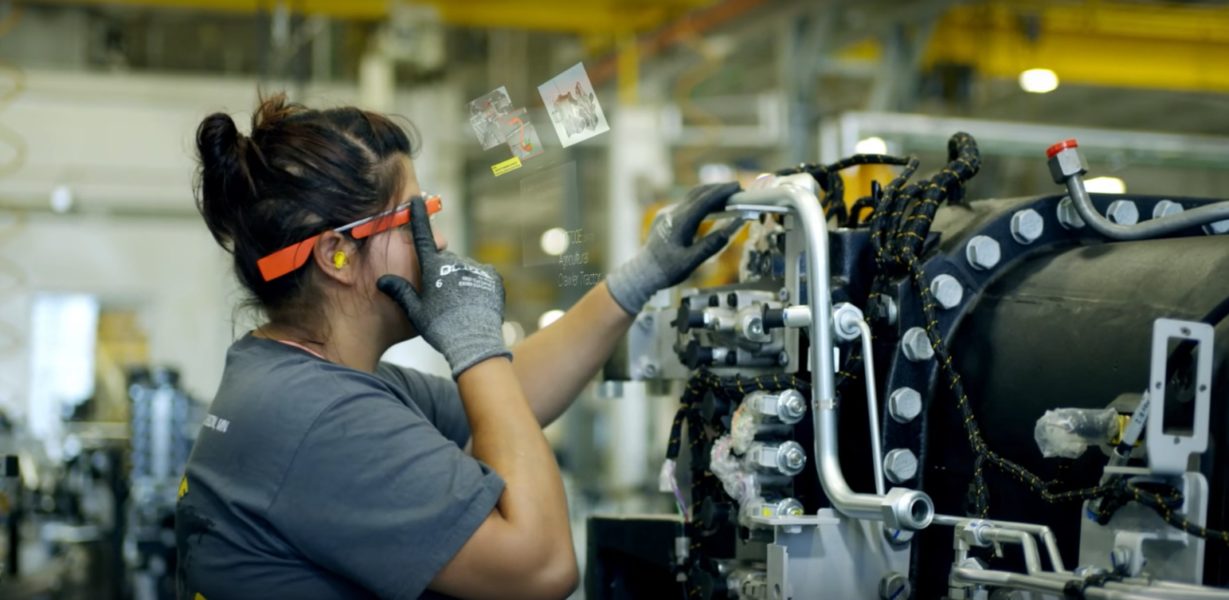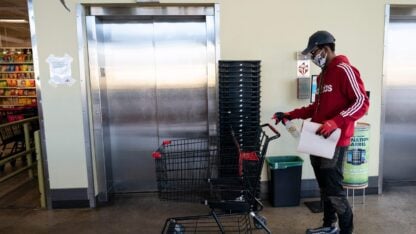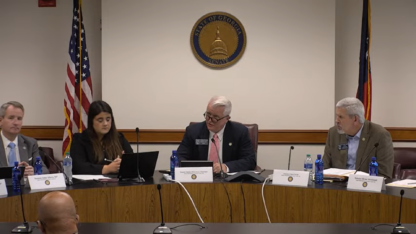Duluth-Based AGCO Uses Google Glass To Build Farm Tractors

Courtesy of AGCO
A broadcast version of this story and interview with AGCO Senior Vice President Hans-Bernd Veltmaat
Google Glass didn’t do so well when it first launched, and is no longer in production for consumers, but the high-tech glasses are getting a second life in manufacturing.
One of the pioneers of this technology is an agricultural manufacturing company based in Duluth, Georgia called AGCO.
Minnesota Plant
At one of AGCO’s factories in Jackson, Minnesota, Heather Erickson is building an engine before it goes on to the assembly line.
She’s wearing her red and black AGCO uniform over her blue jeans. There’s something else on her head: Google Glass.
“It took a little getting used to, but once I got used to it, it’s just been awesome,” Erickson said.
The glasses tell her what to do should she forget, for example, which part goes where.
“It’s a lot better now. I don’t have to leave my area to go look at the computer every time I need to look up something,” Erickson said.
Augmented Reality
With the glasses, she scans the serial number on the part she’s working on. This brings up manuals, photos or videos she may need. She can also use voice commands to take photos or leave notes for the next shift worker.
These augmented-reality devices will soon help workers at other companies like Boeing and General Electric do their work faster and more efficiently.
It’s sort of like the Pokémon Go for manufacturing. Just like the game, which involves catching fictional creatures called Pokémon, Google Glass uses augmented reality.
Images, text and sounds are superimposed or added to what the wearer sees in front of them.
Virtual reality is different from augmented reality in that the goal of virtual reality is to transport and make you feel you are in another physical space. Augmented reality keeps you in your present environment, while adding additional information to your line of sight.
Assembly Lines
AGCO is based in Duluth, but it has 49 factories worldwide where it makes large tractors, chemical sprayers and other farming equipment.
“In the automotive industry, you operate with approximately 4,000 different parts on an assembly line. So a group of 1000 people memorize four parts per person,” said AGCO’s chief supply officer Hans-Bernd Veltmaat. “In our biggest factories, we currently deal with 40,000 parts. That means a worker has to memorize 40 parts and how to assemble them or he needs advice.”
Google Glass provides advice that’s now sitting on workers’ noses, and Veltmaat estimates factory workers are about 3 to 4 percent more productive with them on.
With 1,000 employees, he said that could translate to $1 million in savings.
“Manufacturing is all about efficiency – labor efficiency, material efficiency and machine efficiency,” Veltmaat said. “We try and invest into everything which provides a return to produce at lower cost.”
For now, it’s still in pilot mode. The company only has about 100 employees using the custom glasses. Each one costs about $2,000.
‘Total Gamechanger’
Peggy Gullick is responsible for improving the business flow at AGCO. She says the addition of Google Glass a few months ago has been a “total gamechanger.”
She said quality checks are now 20 percent faster and it’s great for on-the-job training of new employees. Before this, she said workers used tablets.
“Our project is a little over two years old. We were very, very early to the game. We took some consumer Google Glasses and decided to try it on the floor because we had a lot of tablets on our floor and the tablets were being broken just by being dropped,” Gullick said. “Tractors are very tall machines when you’re climbing on and off and you only have one hand to climb with. So we were looking for a solution that offered them more information in a more timely manner from a device that was attached to them so they couldn’t lose it.”
AGCO is the first major manufacturer in the agricultural industry to use Google Glass. Gullick said the company plans to double the number in use at its factories by the end of 2017.
Farming Technology
The agricultural industry is not often associated with revolutionary technology, but it was responsible for pioneering the dual-clutch and continually variable transmission that are now in many cars today.
The industry also doesn’t use the traditional assembly line made popular by Ford more than a century ago, shown in the grainy videos of unfinished automobiles coming to the same point every time, with a worker putting on a wheel.
Instead, parts come to assemblers using what’s called “AGVs,” for Automated Guided Vehicles. It’s like a remote-controlled shoe box.
Veltmaat said they’re now working on technology that will allow farmers to program lots of small, autonomous “tractors,” instead of just one large one. He said these little robot tractors act like swarms of bees.
And in November 2016, AGCO launched a $400,000 tractor, which it calls the biggest and most capable self-driving tractor on the market.
AGCO manufactures agriculture machinery under brands like Challenger, Fendt, GSI and Massey Ferguson.
9(MDAxODM0MDY4MDEyMTY4NDA3MzI3YjkzMw004))








